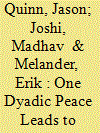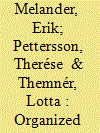|
|
|
Sort Order |
|
|
|
Items / Page
|
|
|
|
|
|
|
| Srl | Item |
| 1 |
ID:
170009


|
|
|
|
|
| Summary/Abstract |
Governments often fight multiple civil conflicts simultaneously and each conflict can have multiple groups. Prior research on civil war termination and recurrence has been conducted at either the conflict level, once all the groups have been terminated, or the dyadic level, which examines group terminations in a conflict separately as more or less independent processes. Hence, conflict-level studies mostly tell us how to preserve peace once a civil war has already ended, while dyadic studies mostly tell us about the durability of specific group-level terminations within the larger process that led to that ending. As a result, our understanding of how ongoing civil wars are brought to a close is limited, particularly, with respect to multiparty conflicts. In this study, we put forth a systems approach that treats dyadic terminations as connected processes where group terminations influence the future behavior of other groups, incentivizing the system toward greater aggregate peace or conflict. Analyzing 264 dyadic terminations, the findings suggest that the most effective strategy for governments to reduce systemic conflict is to demonstrate to other groups that they have the political will and capacity to implement security, political, and social reforms as part of a larger reform-oriented peace process. Viable implementation can be followed by the concomitant use of military victories against remaining groups with great success. However, military victories achieved in isolation, that is, outside of a reform-process, do not reduce future levels of conflict even if they themselves are durable.
|
|
|
|
|
|
|
|
|
|
|
|
|
|
|
|
| 2 |
ID:
147839


|
|
|
|
|
| Summary/Abstract |
The alarming upward trend since 2012 in the number of fatalities incurred by organized violence did not continue in 2015. Indeed, 2014 saw more than 130,000 people killed in organized violence while in 2015 this figure was close to 118,000. This is still an unusually high number, the third-worst year in the post-Cold War period. The number of conflicts continued to increase from 41 in 2014 to 50 in 2015. This increase was by and large driven by the expansion of the Islamic State. Most of the fatalities, over 97,000, incurred in state-based conflicts. Non-state conflicts also increased, from 61 in 2014 to 70 in 2015, the highest number recorded in the 1989–2015 period. No non-state conflict passed the threshold of 1,000 battle-related deaths, but 11 state-based conflicts did – a decrease by one from 2014. Seven of the ten most violent state-based conflicts in 2014 became less violent. Twenty-six actors were registered in one-sided violence just as in 2014, while the number of fatalities decreased from over 13,500 to 9,500.
|
|
|
|
|
|
|
|
|
|
|
|
|
|
|
|
|
|
|
|
|